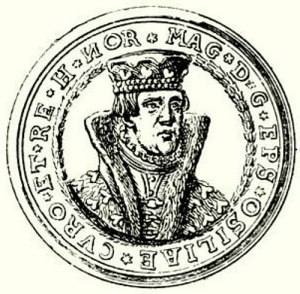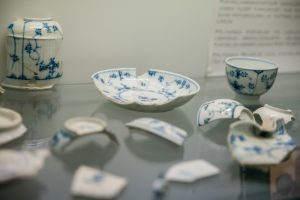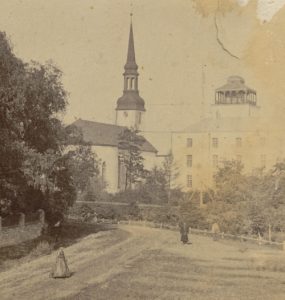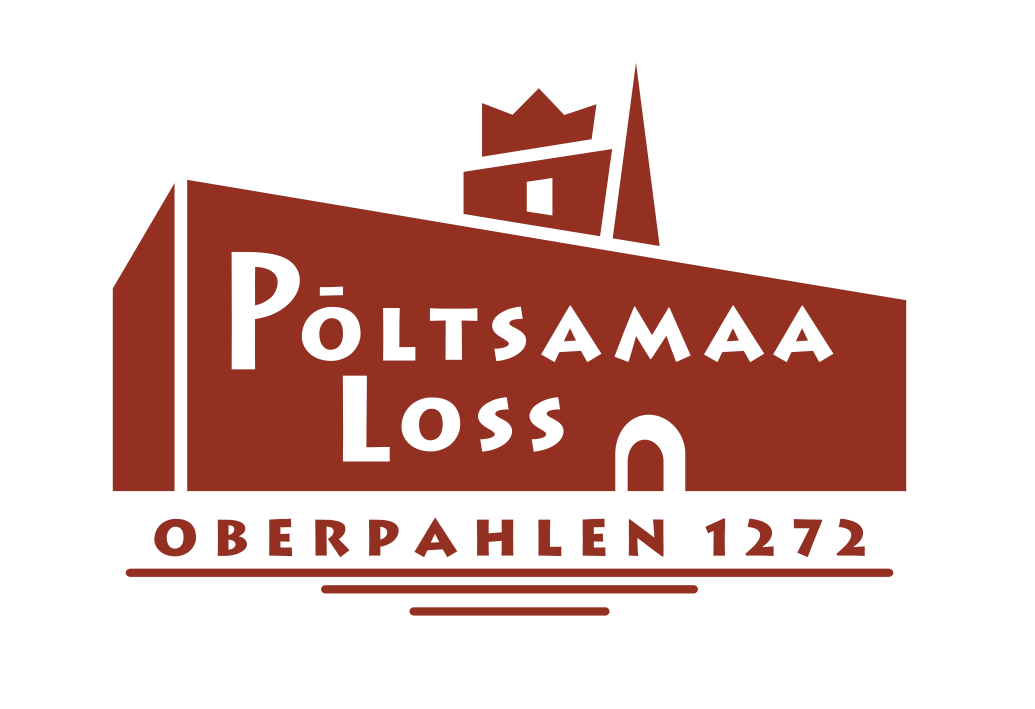Stone fortress was built on the right bank of River Põltsamaa in the center of Mõhu parish in 1272. It was done under the direction of Master of the Order Otto von Rodenstein. The German Order needed a defense building here, as Põltsamaa (in German: Oberpahlen) had become the center of the new bailiwick. Moreover, Põltsamaa has always been an important traffic junction – from here you can get to Paide, Tallinn, Viljandi, Lake Peipsi and Tartu.
The originally built circular wall was initially lower, it is suggested that only a third of the current wall height, and both inside and outside the wall, there were wooden passages. There were large embrasures in the wall, and the corners of the wall were reinforced by towers with an outer wall of stone and an inner wall of wood. Moat, filled with water from the river, added additional protection.
Probably in the 14th century, a convent building was built in the eastern corner of the wall, with a courtyard surrounded by pillars; on the second floor were long single-aisle halls: the capital hall chapterhouse, the refectory and dormitories, and the chapel in the west corner. The third floor was a defense floor and was not completed until the 18th century. To this day, a narrow and steep brick staircase in the tower of the convent building is extant.
In the 16th century, during Russian-Polish-Swedish wars, the fortress was repeatedly attacked and pillaged.

During the Livonian war, in 1570, the Russian Czar Ivan the Terrible appointed Duke Magnus – the younger brother of king Fredrick II of Denmark and the bishop of Ösel-Wiek – the king of Livonia. The castle of Põltsamaa became the residence of King Magnus. On April 12th 1573, the wedding of king Magnus and the daughter of the czar’s nephew, 13-year-old Maria Vladimirovna Staritskaja, was held. Marriage to a grand princess could mean a spot on the Russian throne in the future.
King Magnus was given 25 000 men to command and was supposed to conquer new lands for the Czar. The Czar was particularly interested in Tallinn, which was under the governance of the Swedes. Since Magnus wasn’t able to conquer Tallinn, Ivan the Terrible was furious and sent his army to finish off the kingdom. Magnus and Maria fled to Riga in a boat across the Livonian Bay to seek refuge with the Poles.
The Swedish-Polish war, which began in 1600, crossed Põltsamaa several times, as well as the fortress and smaller manor houses, and the landowners changed. In 1600, the medieval church (1234) was destroyed, of which there is only one work of art on earth – the corner console “Kiss of Põltsamaa“, which is now located in this museum.
In 1623, king Gustav II Adolf gave Põltsamaa to marshal Hermann Wrangel – during his time, the life in the manor started to get better again. Reconstruction of the buildings in ruins began.
Between 1632 and 1636, a large number of construction masters from Tallinn, Tartu and other cities worked in Põltsamaa. The castle and church were repaired, ancillary buildings were built up: mills, threshing barns, cattle yards, etc. Unfortunately, these buildings did not have a long life. During the Swedish-Polish war, which broke out again in 1658, the Poles invaded Põltsamaa and burned them off again.
However, Põltsamaa was able to recover again. The protocols of the revision of 1682 mention the manor ensemble consisting of more than 20 buildings. At the beginning of the Great Northern War, the Russians invaded Põltsamaa and burned the castle.
After the Great Northern War, in 1720, Heinrich Claus von Fick, State Counselor of Peter I, asked for the areas of Põltsamaa to himself. The idea to ask for this estate was proposed to him by the godmother of his daughter Aurora, Maria Aurora von Köningsmark, whose grandfather, Swedish marshal Hermann von Wrangell, had been the owner of these lands during the Swedish reign. Fick started developing the economy of Põltsamaa with the aim of creating a leading model settlement here to the whole of Russia.
In 1750, after the sudden death of Fick, his property was divided between his five daughters based on his will. Põltsamaa Castle was given to Fick’s daughter Aurora and her husband Woldemar Johann von Lauw. Lauw, born in Pärnu County in 1712, had studied at the University of Jena, served in the Russian army, lost his left arm in the Russo-Turkish War, leased the island of Muhu and married Aurora von Fick in 1746, moved to Põltsamaa. Fr. Amelung’s report “Studien zur Geschichte Oberpahlens und seiner industriellen Blüthezeit” describes in detail W. J. von Lauw’s activities in Põltsamaa. His fahter-in-law had wanted to turn the town into a prosperous settlement with a well-functioning economy, which would be an example for the whole empire, Lauw continued the work of his father-in-law. He founded copper, scratch and tanning factories in Põltsamaa and also a green glass factory that produced different green hollow glass as well as bottles and glass containers for medical puproses.
As his smaller ventures had been successful, he had sufficient confidence by the government. He was granted a loan against collateral, and even public funds were made available to him. At a time, when there was only one company in all of Livonia outside Riga and Tallinn that deserved to be called factory (Räpina Paper Mill), Major von Lauw established three more factories almost simultaneously: a porcelain manufactory in Põltsamaa, a window glass factory in Tõrna and a Kamari-Põltsamaa mirror factory. For further processing of mirror glass, grinding, polishing and mirror coating rooms had to be built at the same time. 12 grinding devices, 4 polishing mills and 6 grinding plates were put into operation. 10 of the workers were Estonians and 10 were newly trained hand grinders of Russian origin. In addition to some other Estonian handymen, all the others – polishers and grinders – were among the German masters. Although carriage windows, shaving and wall mirrors made at the Lauw mirror factory were a sought-after commodity due to their novelty, the owner still had to pay thousands of extra rubles a year because of the high production costs. Despite all efforts, the company became unprofitable and operated for four years only (until Lauw’s death).

In 1782, Lauw founded the porcelain manufactory of Põltsamaa Castle. White-blue-painted bowls, plates and other dishes from the Põltsamaa porcelain manufactory were once highly valued goods and have been widely used by citizens in the cities of our country. Apparently porcelain figurines were also made. Unfortunately, the high costs of this factory were not covered, so it had to close down during Lauw´’s lifetime.
Around 1770, the dilapidated convent building of the old fortress was rebuilt into a fine rococo palace by Lauw. The most beautiful halls were located in the southeast wing of the main floor: the marble and rococo hall. The rooms were decorated with rich stucco framing. Before Põltsamaa, stucco master Johann Michael Graff from Berlin had been working in the Rundāle and Jelgava palaces. The ceiling of the Marble Hall was decorated with reliefs, the walls were panelled with artificial marble, the lower part of the walls with wine coloured panelling, the higher parts with pink and light grey. The walls were covered with Venetian mirrors surrounded also by rich stucco framing. White gypsum decorations on the ceiling very truthfully pictured flowers and plant leaves, there were also plenty of bird images which seemed to be the favourite motif of the artist. There were also shell motifs after which the Rococo style has been named. The walls of another grand hall, the Rococo Hall, were covered with large oval paintings in brown hues in grisaille technique by Gottlieb Christian Welté. He remained the artist of the palace for five years. His paintings of Põltsamaa can also be found in the collections of the Estonian Art Museum. Friedrich Hartmann Barisien was ordered to paint the landscapes of the palace as well as the portraits of the czars. There were also three bas-reliefs on the walls of the Rococo Hall, the busts were of the W. J. von Lauw, Aurora von Lauw and possibly one of their daughters. A two-storey, late baroque ruler house was built along the southwest wall of the fortress, which is crossed by a gate.
As the master of the palace, Lauw had a grand lifestyle. The palace had its own orchestra and an Italian opera troupe with a much-praised dark-skinned maiden as leading lady; Lavish hunting parties and balls were held all the time.
But von Lauw also took care of the poor. In 1766, a hospital was opened for the lower class people. Doctor Peter Ernst Wilde from Riga was invited to lead the hospital. At the medical school established at the hospital, Wilde taught medicine to young men; at the same time, he founded pharmacy in Põltsamaa – the first rural pharmacy in Estonia – and a printing house, where he published a medical magazine. In 1766, the first periodical in Estonian called “Lühhike öppetus” (Estonian for Brief Instruction) was printed in Põltsamaa. The pastor of Põltsamaa, A. W. Hupel translated its content from Wilde’s notes.
Major von Lauw died unexpectedly on February 15th, 1786. The government, as Lauw’s main creditor, subsequently sold Põltsamaa castle and empress Catherine the Great gave the castle for rent to her son, Major General Aleksei Bobrinsky (1762–1813). Catherine II sent her son to Estonia in 1788 as a punishment for his dissolute life and his card game debts in Paris. Bobrinski married Anna, the daughter of the Tallinn commandant Ungern-Sternberg. He built an observatory in the tower of Põltsamaa castle, renovated the interior of the building, and spent a total of 9 years in Estonia. His daughter Maria Bobinskaya inherited the manor and through marriage, it remained in the hands of the Gagarin family until 1920. One of the prides of Põltsamaa Castle was the library of Count Bobrinski.

When World War I started, the army was located in Põltsamaa Castle. At the beginning of the war, the wooden part of the castle tower had been demolished for strategic purposes. The manor had been in a rather good shape until it was taken over in December 1917 by bolsheviks. When the German occupation got there in 1918, the place was pillaged: the furniture had been broken and boxes of documents ransacked. Books of the castle library had been sold in Tartu Supilinn.
During the first period of independence of the Republic of Estonia, the castle was used for orchestral rehearsals and parties. The museum and the Defense League had their own rooms. In 1938, even some repair works were done. But on July 14, 1941, both Põltsamaa Castle and the church were burned down, the church was quickly restored (1952). The restoration of the historic buildings of the castle complex began in 2020. Within the historic walls of the castle, visitors will find museums, exhibition halls, handicraft workshops and a wine cellar; concerts and other outdoor events take place in the summer.
Original article in Estonian by: Rutt Tänav
